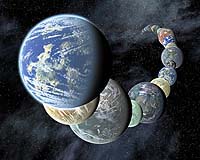|
|
|
"Barcelona Process" Established To Guide Search For Habitable Exoplanets Barcelona, Spain (SPX) Oct 14, 2009  Exoplanet scientists from around the world gathered in Barcelona from September 14 to 18 to debate and reach a consensus on defining guidelines for a new roadmap with the ultimate objective of finding habitable, and potentially inhabited, planets outside of our Solar System. In addition they reached an agreement on an appropriate framework for developing such an initiative. ... read more
Exoplanet scientists from around the world gathered in Barcelona from September 14 to 18 to debate and reach a consensus on defining guidelines for a new roadmap with the ultimate objective of finding habitable, and potentially inhabited, planets outside of our Solar System. In addition they reached an agreement on an appropriate framework for developing such an initiative. ... read moreSky Merger Yields Sparkling Dividends  Pasadena CA (SPX) Oct 14, 2009
Pasadena CA (SPX) Oct 14, 2009A recent NASA/ESA Hubble Space Telescope image captures what appears to be one very bright and bizarre galaxy, but is actually the result of a pair of spiral galaxies that resemble our own Milky Way smashing together at breakneck speeds. The product of this dramatic collision, called NGC 2623, or Arp 243, is about 250 million light-years away in the constellation of Cancer (the Crab). ... more
|
Vietnam says parched Red River at record low
China to be world's third biggest wind power producer: media Cost-cutting NASA eyes three cheap space missions Honduras declares state of emergency amid drought Russia in secret plan to save Earth from asteroid: official Sarkozy scrambles to salvage carbon tax French carbon tax ruled illegal Brazil's Lula signs law cutting CO2 emissions 2009 a 'benign' year of natural disasters: German re-insurer Greenpeace Spain demands Denmark release its director
| |||||||||||||||
| Previous Issues | Oct 13 | Oct 12 | Oct 09 | Oct 08 | Oct 07 |
| . |
How Do We Know That Planets Exist Outside Our Solar System Bonn, Germany (SPX) Oct 13, 2009
Bonn, Germany (SPX) Oct 13, 2009Even in ancient times, people observed the planets that orbit our Sun. (See also the astronomy question from week 1: Why are there seven days in a week?) Nowadays we know that there are many trillions of other stars in the Universe, in addition to the Sun. It seems likely that planets orbit many of these stars too. The evidence that extrasolar planets (exoplanets for short) exist was ... more NASA Spacecraft Impacts Lunar Crater In Search For Water Ice  Moffett Field CA (SPX) Oct 12, 2009
Moffett Field CA (SPX) Oct 12, 2009NASA's Lunar Crater Observation and Sensing Satellite, or LCROSS, created twin impacts on the moon's surface early Friday in a search for water ice. Scientists will analyze data from the spacecraft's instruments to assess whether water ice is present. The satellite traveled 5.6 million miles during an historic 113-day mission that ended in the Cabeus crater, a permanently shadowed region ... more UBC Engineering Students Unveil Moon Dust-Shoveling Robot  Vancouver, Canada (SPX) Oct 12, 2009
Vancouver, Canada (SPX) Oct 12, 2009A robot designed by UBC students will be shoveling moon dust at an international robotics competition next week, vying for a $500,000 prize and the opportunity to contribute to NASA's future space exploration projects. The UBC team has created a robotic machine that can excavate simulated lunar soil (regolith). Excavating regolith will be an important part of any construction project or ... more |
. |
| . |
Western Astronomers Capture Spectacular Meteor Images London, Canada (SPX) Oct 08, 2009
London, Canada (SPX) Oct 08, 2009Astronomers from The University of Western Ontario have released footage of a meteor that was approximately 100 times brighter than a full moon. The meteor lit up the skies of southern Ontario two weeks ago and Western astronomers are now hoping to enlist the help of local residents in recovering one or more possible meteorites that may have crashed in the area of Grimsby, Ontario. ... more Spitzer Discovers Saturn's Largest Ring  Pasadena CA (SPX) Oct 08, 2009
Pasadena CA (SPX) Oct 08, 2009NASA's Spitzer Space Telescope has discovered an enormous and previously unknown infrared ring around Saturn. "This is one supersized ring," says Anne Verbiscer, an astronomer at the University of Virginia, Charlottesville. "If you could see the ring in the night sky, it would span the width of two full Moons." Verbiscer is co-author of a paper about the discovery to be published online to ... more NASA Refines Asteroid Apophis' Path Toward Earth  Pasadena CA (SPX) Oct 08, 2009
Pasadena CA (SPX) Oct 08, 2009Using updated information, NASA scientists have recalculated the path of a large asteroid. The refined path indicates a significantly reduced likelihood of a hazardous encounter with Earth in 2036. The Apophis asteroid is approximately the size of two-and-a-half football fields. The new data were documented by near-Earth object scientists Steve Chesley and Paul Chodas at NASA's Jet ... more |
. |
| Previous Issues | Oct 13 | Oct 12 | Oct 09 | Oct 08 | Oct 07 |
| The contents herein, unless otherwise known to be public domain, are Copyright 1995-2009 - SpaceDaily. AFP and UPI Wire Stories are copyright Agence France-Presse and United Press International. ESA Portal Reports are copyright European Space Agency. All NASA sourced material is public domain. Additional copyrights may apply in whole or part to other bona fide parties. Advertising does not imply endorsement, agreement or approval of any opinions, statements or information provided by SpaceDaily on any web page published or hosted by SpaceDaily. Privacy statement |